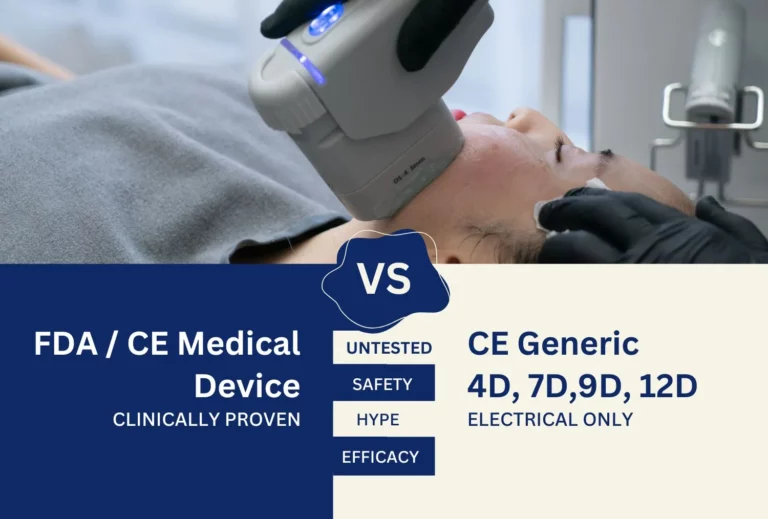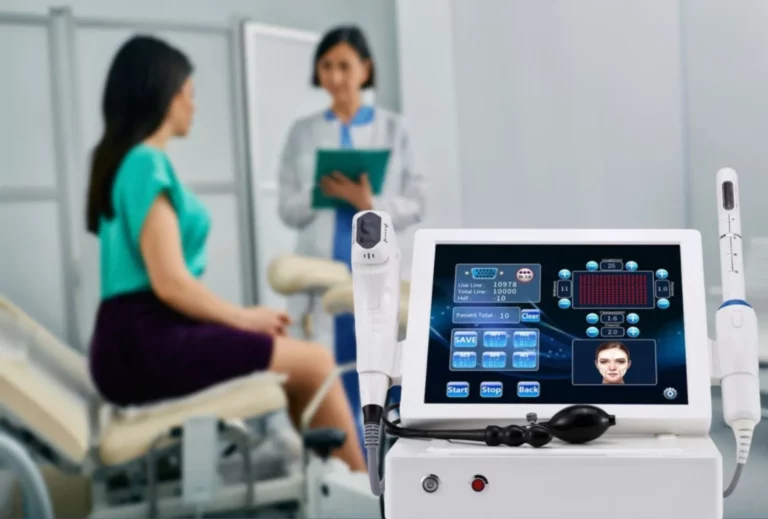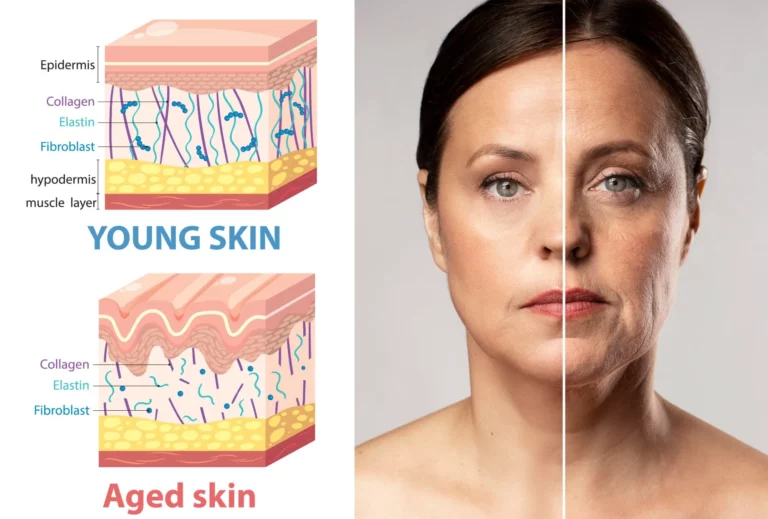High-intensity focused ultrasound (HIFU) is a non-invasive medical technology that uses focused ultrasound waves to precisely destroy pathological tissues. This method is widely used in oncology and other medical fields, offering an alternative to traditional surgical and radiotherapy approaches.
Principle of operation of HIFU technology as “bloodless surgery”
The operating principle of HIFU is similar to that of magnifying glass focusing sunlightMany ultrasound beams pass through the surface layers of skin and tissues, leaving them unharmedOnly in the precisely defined focal point – an area measuring about 1 mm in diameter and 10 mm long – energy is concentrated, causing powerful biological changes.
I. Dual mechanism for precise destruction
HIFU can be controlled to achieve various therapeutic effects, which are mainly divided into thermal and mechanical.
1. Thermal Ablation
This is the most widely used mechanism for tumor destruction (ablation):
- Heating to cytotoxic levels: At the focal point, the ultrasound energy is absorbed by the tissues and converted into heat. This results in rapid rise in temperature, usually above 60°C, and in some systems up to 90°C.
- Coagulative necrosis: This high temperature causes denaturation of cellular proteins, which leads to immediate and irreversible cell death (coagulative necrosis). If the temperature is maintained above 60°C for more than 1 second, immediate death of most cells occurs.
- Precision limit: This effect is so precise that it creates a very sharp border between destroyed (dead) and healthy (living) cells, which can be wide not more than 50 µm.
2. Mechanical effect (Cavitation)
When HIFU is applied with high power and very short pulses, mechanical effects predominate:
- Acoustic cavitation: This is a process in which ultrasound waves interact with dissolved gases in the tissue (microbubbles), causing them to oscillate or collapse.
- Destruction (Hystotripsy): The strong one, inertial collapse of the microbubbles generates a shock wave that mechanically disrupts cell membranes, destroying the tissue (histotripsy).
- Drug Delivery (Sonoporation): At lower intensity levels, the microbubbles oscillate stable, creating temporary pores in cell membranes (sonoporation). This reversible process increases permeability and allows drugs or gene therapies to enter target cells.
II. Main areas of application of HIFU in medicine
HIFU applications fall into three main categories: direct tissue destruction (ablation), targeted drug delivery, and other supporting mechanisms.
1. Destruction of diseased tissues (Ablation)
1.1. Oncological treatment (Tumors)
HIFU is used as a non-invasive method for treating various malignant (cancerous) and benign (non-cancerous) tumors.
- Prostate cancer: HIFU is a non-invasive method for treating localized prostate cancer. It allows for precise destruction of the tumor while trying to preserve the nerves and muscles responsible for sexual function and urinary control.
- Liver cancer (HCC): HIFU is used to destroy tumors in the liver. In many cases, it is combined with other therapies, which increases effectiveness.
- Benign formations: HIFU is an effective and safe treatment option for uterine fibroids (uterine myoma) – a common gynecological tumor. This approach leaves no surgical scars and is suitable for women who want to preserve their uterus.
- Other tumors: It is used to treat tumors in breast (e.g. fibroadenomas), kidneys and pancreas.
1.2. Neurosurgery (Brain Diseases)
- Tremor: HIFU (usually MR-guided, or MRgFUS) has been shown to be effective in reducing essential tremor (uncontrollable shaking) and tremor associated with Parkinson's diseaseHIFU destroys a small, specific area in the brain (thalamus) without opening the skull.
1.3. Bone diseases
- HIFU is used to relieve pain caused by metastases (spread of cancer) in the bones.
- In children and young people, HIFU is used to destroy osteoid osteoma – a type of benign bone tumor.
2. Targeted drug delivery
HIFU can work in combination with medications to ensure they reach the diseased area in high concentration.
2.1. Penetration into the brain (Opening the CMB)
HIFU, often with the help of microbubbles, may temporarily open the blood-brain barrier (the thick barrier that prevents most drugs from reaching the brain). This allows drugs, antibodies, or gene therapies to enter the brain to treat tumors, Alzheimer's disease or Parkinson's diseaseThe opening of the barrier is temporary and reversible.
2.2. Precise drug release
Drugs can be encapsulated in special media (e.g. liposomes or microbubbles) that are sensitive to heat or pressure.
- HIFU focuses on the tumor to cause mild hyperthermia (moderate heating, about 42°C). This heat causes the media to release the medicine directly into the target area.
- This is especially useful in chemotherapy, as reduces toxicity on healthy cells.
2.3. Increasing cell permeability
The mechanical effects of HIFU (stable cavitation) can temporarily create small pores in cell membranes (sonoporation), which facilitates the entry of drugs or genes into cells.
3. Other mechanisms and supporting effects
- Increased sensitivity to other treatments: The mild hyperthermia (heating) achieved with HIFU can increase metabolic activity of cancer cells, making them more sensitive to chemotherapy and radiotherapyThis allows the same effect to be achieved with lower radiation doses.
- Fighting clots (Thrombolysis): HIFU can be used for breaking up blood clots in vessels (for example, in a stroke) by mechanical forces. This method can restore normal blood flow.
- Stopping bleeding (Hemostasis): The thermal effect of HIFU can close injured blood vessels and stop internal bleeding by clotting (coagulation).
- Immune stimulation: The destruction of tumor tissue by HIFU (through heat or mechanical disruption) can activates the immune system the body to recognize and attack cancer cells.
- Palliative treatment: HIFU is also used to relieve pain in patients with bone metastases, offering rapid relief compared to traditional radiotherapy.
III. Advantages of HIFU therapy
Overall, HIFU offers significant advantages over traditional methods, including: less invasiveness, faster recovery (often within a few days), low risk from infections and lack of exposure to ionizing radiation (as it is guided by MRI or diagnostic ultrasound).
IV. Future and challenges of HIFU in medicine
Interest in HIFU has increased significantly, but despite promising clinical results (especially in fibroids and tremors), the technology is still in its early stages of development.
Main directions for future research:
- Oncology: Further research is needed on long-term medical benefits in cancer treatment and a better understanding of its role in combination with other therapies.
- Neurology: Further studies are required to determine the optimal parameters for opening the CMB in neurodegenerative diseases such as Alzheimer's disease.
- Standardization and technical aspects: The heterogeneous nature of protocols in clinical trials, especially in the treatment of HCC, makes comparative analysis difficult. To ensure wider acceptance, technical parameters (frequency, power, exposure time) need to be standardized and better reported.
- Safety: Although HIFU is generally safe, attention should be paid to rare side effects, such as: skin burnsIn cardiological applications (e.g. atrial fibrillation ablation) there have been safety concerns, such as atrio-esophageal fistulas.
Conclusion: The key added value of HIFU is expressed in its millimeter precision, controlled by imaging (MRgFUS). This allows bloodless destruction of deep-seated tumors and non-invasive functional neurosurgery for the treatment of movement disorders. Although the technology is still in its early stages and requires more data on long-term benefits, it has the potential to provide treatments with less trauma, faster recovery and lower risk.



